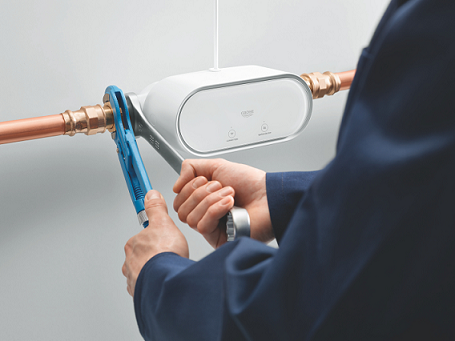How can technology help you mitigate escape of water claims?
-
Market Insight 11 March 2021 11 March 2021
-
UK & Europe
With the increasing standards of modern finishes in kitchens and bathrooms, the cost of tracing and repairing escapes of water has escalated dramatically in recent years. As an example, data from the Association of British Insurers indicates that in 2018, damage caused by escapes of water constituted 31% of claims and cost about £650 million. This represented by far the largest proportion of claims types, with the next largest being fire claims at 17%.
http://www.hawkins.biz/insightsAuthor: David Reid Rowland, Principal Associate, Hawkins
How leak detection can reduce the extent and cost of escape of water damage
Whilst it is likely that escapes of water will continue to occur, the use of leak detection devices is increasingly being adopted to mitigate the extent and cost of the resulting damage. These employ different operating principles but generally will allow a home or building owner to detect and/or stop escapes of water. Currently, they tend to be installed predominantly in commercial or high value residential properties but many of these solutions are becoming increasingly inexpensive and more widespread.
How do these devices work?
Leak detection devices normally adopt one, or sometimes both, of two different technologies, which involve either monitoring the flow of water into a property for abnormalities, or the use of electrical or optical sensors placed at suitable locations to detect the presence of water after it has escaped.

The first type of leak detection technology involves continuously monitoring the flow of water into a property for abnormalities. The most basic examples of this type of system can be retrofitted to existing pipework or water meters, and so do not require specialist installation. The sensor type that is fitted to water meters detects the small electrical impulses given off by modern meters as water flows through them. The type that can be attached to existing pipework monitors the temperature of the water pipe and the ambient air temperature, on the basis that water flowing through a pipe will tend to lower or change its temperature. Other types of flow monitoring devices are fitted in-line with the water pipe and measure the flow in a similar way to a conventional water meter. These flow monitoring devices are normally designed to work in one of two ways. Some devices will activate after a pre-set volume of water has flowed without interruption, which normally indicates a burst pipe. The pre-set volume needs to be sufficiently large that the devices do not activate erroneously and become a nuisance to the home or building owner. They can also be configured so that the volume required to trigger the system is reduced when the property is unoccupied. More sophisticated flow detection devices track the normal usage patterns in a property and will activate when they deem the water usage to be unusual. Both system types can also identify slow continuous leaks, such as hidden dripping joints, and alert the owner or isolate the water supply to the property accordingly. The advantage of these types of system is that they will tend to identify an escape of water regardless of its position in the property, but the disadvantage is that a large volume of water can escape before the leak is detected.
Other leak detection systems operate by using electrical or optical sensors that detect the presence of water that comes into contact with them. With the electrical sensors, contact with water results in a change in the electrical resistance of the cable or probe, which can be detected by the device. These sensors are normally placed in locations where water leaks might be expected, such as beneath kitchen units or in bathrooms. The disadvantage of this type of system is that if the leak is remote from the sensor, for example, within a wall or ceiling void, the leak might not be detected at all.
Upon activation, some of the devices will alert the property owner by sounding a local audible alarm and others can alert remotely by either sending text messages or through mobile phone applications. The downside of this type of ‘alert only’ system is that they require someone to attend promptly to manually isolate the water supply. Even if these alarms are reacted to promptly, many property owners might not know where to locate their stopcocks and in some cases, the stopcock can become seized if it has not been operated for several years, which is often the case for stopcocks and outside stop valves. More sophisticated units incorporate electrical solenoid valves that close automatically to isolate the water supply in the event of an activation. These devices also allow the homeowner to isolate the water supply when they leave the house for a prolonged period, such as going away on holiday. Some leak detection systems even incorporate low ambient temperature monitoring and can either alert the property owner or isolate the water supply during freezing weather conditions, in order to prevent escapes of water caused by pipes bursting.
Whilst it is inevitable that escapes of water will continue to occur, leak detection technology has an important part to play in mitigating the severity of damage that occurs as a result.
Clyde & Co comment
It is clear that technology can greatly assist insurers in both reducing the extent of damage caused by an escape of water event but also, critically, by helping to prevent the escape of water from occurring in the first place. The general consensus is that the situation is “win win” given that insurers’ losses ought to be substantially limited and customers will be protecting their property.
Insurers have been promoting the incorporation of this technology for some time. Some insurers have even decided to offer a leak detection device for free to their customers as part of their service. At the very least it is anticipated that more insurers will start to ask customers if they benefit from any water leak prevention device upon presentation of a risk, with the enticement of reduced insurance premiums or a lower excess to pay in return.
Considerations for insurers
As leak detection devices become more common, insurers will need to give serious consideration to their insurance policy terms and whether they wish to limit or exclude cover for claims made in situations where a customer has failed to respond to a potential leak alert or say, has failed to keep the device maintained. A standalone condition governing maintenance of a device, and the evidence of upkeep for a customer to retain, may be prudent. Any dispute about cover would then need to be interpreted in accordance with section 11 of the Insurance Act 2015. If insurers routinely decide to offer technology as standard, they will want to ensure their liability is limited in the event the device was to fail.
Whilst primarily the leak detection system will mitigate the extent and severity of water damage, it is anticipated that the technology will also assist litigation in that it should allow forensic experts to interrogate the unit to establish when a leak started and how much water escaped. This will be especially beneficial for slow leaks.
This content was written by BLM prior to its merger with Clyde & Co.
David Reid Rowland is a Principal Associate at Hawkins, a leading forensic engineering consultancy. He has investigated the cause of several hundred escapes of water for insurers and solicitors. For more information and other articles on escapes of water please visit www.hawkins.biz/insights.
If you are concerned about your property damage claims portfolio and would like support from the team on the issues affecting insurers, brokers, property developers, property owners, as well as residential and commercial landlords within the property damage space, then please do get in touch.
End
